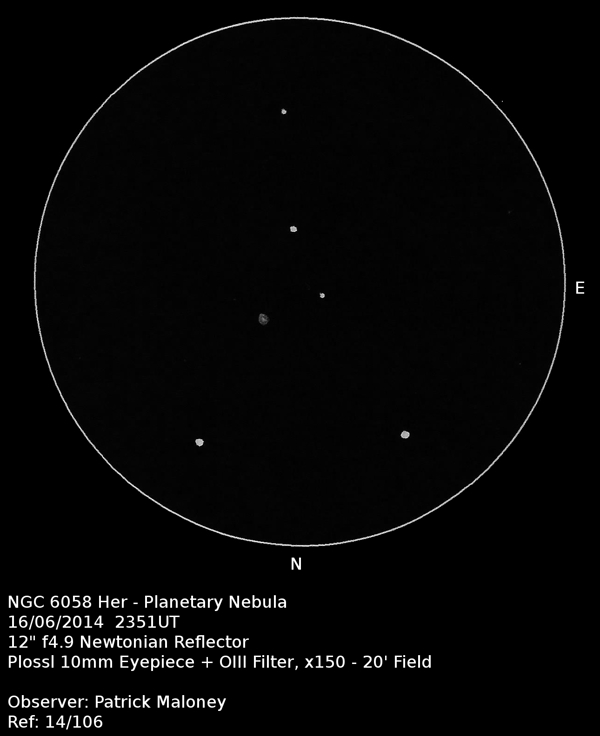NGC 5634 in Virgo and NGC 6058 in Hercules
May 2021 - Nebula and Cluster of the Month
The sky continues to be dominated by galaxies throughout May. If you want a small break from the extragalactic wonders, here are a couple of objects from within our own Galaxy that you may find interesting.
Our cluster this month is a remote globular, located about halfway between the galaxy fields of Virgo and Antares in Scorpius, almost due south of Arcturus.
It was discovered, like most of the objects in this column, by William Herschel. He first sighted it on 5th March 1785 and described it as very bright, considerably large, irregularly formed, very gradually brighter towards the middle.
He placed it in his category I, bright nebulae, as no 70. In 1888 it entered the NGC as no 5634.

The fact that he placed the object in his ‘bright nebulae’ category rather than under one of his three ‘clusters’ categories suggests, like his description, that he was unable to resolve any stars. I can find no direct information about the magnitude of the brightest stars in the globular, but there is a rough correlation between the overall magnitude of a globular cluster and the magnitude of its brightest stars. For a cluster as bright as NGC 5634 (mag 9.4), I would expect the brightest stars to be between magnitudes 14 and 15. As it reaches a maximum altitude of about 30° from Britain, this would probably explain why Herschel could not detect any stars.
NGC 5634 is one of a small number of globular clusters that have probably been stripped from dwarf galaxies captured by the Milky Way. More work is needed, but it seems likely that it originally resided in either the Sagittarius Dwarf Spheroidal Galaxy or the Sagittarius Dwarf Elliptical Galaxy. It lies at a distance of over 82,000 light-years, about four times the distance to M13, for example.
It is a class IV globular cluster, indicating that it has a moderately rich concentration towards the centre. The higher the concentration, the easier a globular is to see visually, and a class IV object should present little difficulty.
I observed it with a 12” (300mm) Newtonian reflector in 2014, before the imposition of the blue LED streetlights that completely wiped out my sky. I noted that the object appeared bright, small and compact. No resolution was achieved, even at x375, though the object did appear distinctly mottled.

For this month’s nebula, we’re moving north to Hercules, to find the planetary nebula NGC 6058, another Herschel discovery. He discovered it on 18th March 1787, when he catalogued it as the 637th entry in his category III, very faint nebulae. He described it as very faint, extremely small. 300 [power] showed two very small stars with nebulosity
.

NGC 6058 lies about 10,000 light-years away and has a true diameter of a little less than half a light-year.
It is not especially bright, shining at magnitude 12.9. Kent Wallace, in Visual Observations of Planetary Nebulae reports that using an 8” (200mm) reflector, he needed an OIII filter to identify the object.
I observed this planetary nebula under a June twilit sky and was surprised at how bright it seemed, even against the twilight. At x83 I found it to be round and distinctly non-stellar. I noted that it was sharply brighter in the middle, but I didn’t think I had seen the central star. It would appear that I was mistaken, as the central star is bright (magnitude 13.6) and there is nothing else at the centre of the nebula! I found that use of the OIII filter noticeably increased the apparent diameter of the object.

Herschel’s two very small stars
are the central star and a 15.9 magnitude star on the northern edge of the nebulosity.
Patrick Maloney (DeepSkyBagger@gmail.com)
| Object | RA | Dec | Type | Magnitude |
|---|---|---|---|---|
| NGC 5634 | 14h 29m 37s | -05° 58’ 33” | Globular cluster | 9.4 |
| NGC 6058 | 16h 04m 27s | +40° 41’ 05” | Planetary nebula | 12.9 |